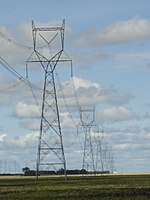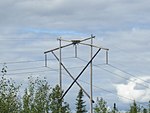This page is dedicated for the mapping of power-related infrastructure in Manitoba.
Background
The Manitoba power grid uses transmission voltages also used in nearby provinces and U.S. states, except for 66 kV subtransmission. Distribution lines are usually 12.47 kV and 24.94 kV (or 25 kV in common usage), the standard distribution voltages in Canada, but a 4.16 kV system remains in large cities like Winnipeg. The whole Manitoba grid, including distribution, is a provincial monopoly under the crown corporation Manitoba Hydro. The Manitoba grid generally brings power from the hydroelectric power plants in the north to the load centres in the south, most notably via the Nelson River Bipole high voltage direct current (HVDC) transmission line. The grid connects with the U.S. grid, SaskPower's Saskatchewan grid and Hydro One's Ontario grid.
All existing power lines in Manitoba presently mapped can be seen in OpenInfraMap
Voltages
| Voltage
|
Network
|
Notes
|
Appearance
|
Example
|
| 500 kV
|
Transmission
|
Only used in lines connecting Winnipeg with the Nelson HVDC and the United States. Nelson River HVDC also uses this voltage.
|
Single-circuit towers
|

|
| 230 kV
|
The vast majority of Manitoba Hydro's transmission backbone. Most hydroelectric dams connect to the 230 kV network.
|
Lattice towers or H-frame structures. Some 115 kV lines in cities use steel poles because of esthetic concerns.
|

|
| 138 kV
|
Generally used in northern Manitoba.
|
|
| 115 kV
|
Mostly used to supply the 66 kV subtransmission system in most of Manitoba and 24.94 kV systems in some areas.
|
|
| 66 kV
|
Subtransmission
|
Common subtransmission voltage, that feeds from either the 230 kV or 115 kV grid. The 12.47 kV network connects to the 66 kV system.
|
Taller poles with 3 cables, sometimes with a 12.47 kV feeder. Most lines have disconnector switches, and many branch out to large customers. Also used to feed the legacy 4.16 kV networks in Winnipeg and Brandon.
|
|
| 24.94kV
|
Distribution
|
Used in some areas, and fed by the 115 or 138 kV system.
|
Ordinary sized poles in rural areas and back alleys, or underground cables. Multiple circuits may not be obvious from aerial photography. 24.94 and 12.47 kV systems are generally looped, with many single-phase or three-phase branches and backup connections from other substations provided by open disconnector switches at the end of feeders.
|
|
| 12.47 kV
|
Used in the majority of the distribution system. Supplied through 66 kV lines.
|
|
| 4.16 kV
|
Legacy voltage used by City Hydro, since acquired by Manitoba Hydro. Also used in Brandon. Also fed by 66 kV systems.
|
|
| 120/240 V split-phase, 120/208 V three-phase, 347/600 V three-phase
|
Standard voltage for end customers. These voltages are supplied by a pole-mounted transformer (in rural area or back alleys) or pad-mount transformer (in cities).
|
Note that some older transmission lines are posted under 110, 132 and 220 kV (for 115, 138 and 230 kV respectively), but the latter voltages will be used for sake of consistency.
Tagging recommendations
- Lines from 120/240 V to 24.94 kV - power=minor_line
- Lines from 66 kV and above - power=line
- Steel or wood poles on transmission lines from 66 kV - power=pole (poles with cross-arms attached through a V-shaped bracket, only used in 66 kV lines) or power=tower (H-frames, steel poles with cross-arms attached to the tower through screws and bolts)
- Lattice towers - power=tower
- Distribution line poles - power=pole (all single poles), power=tower (H-frames)

